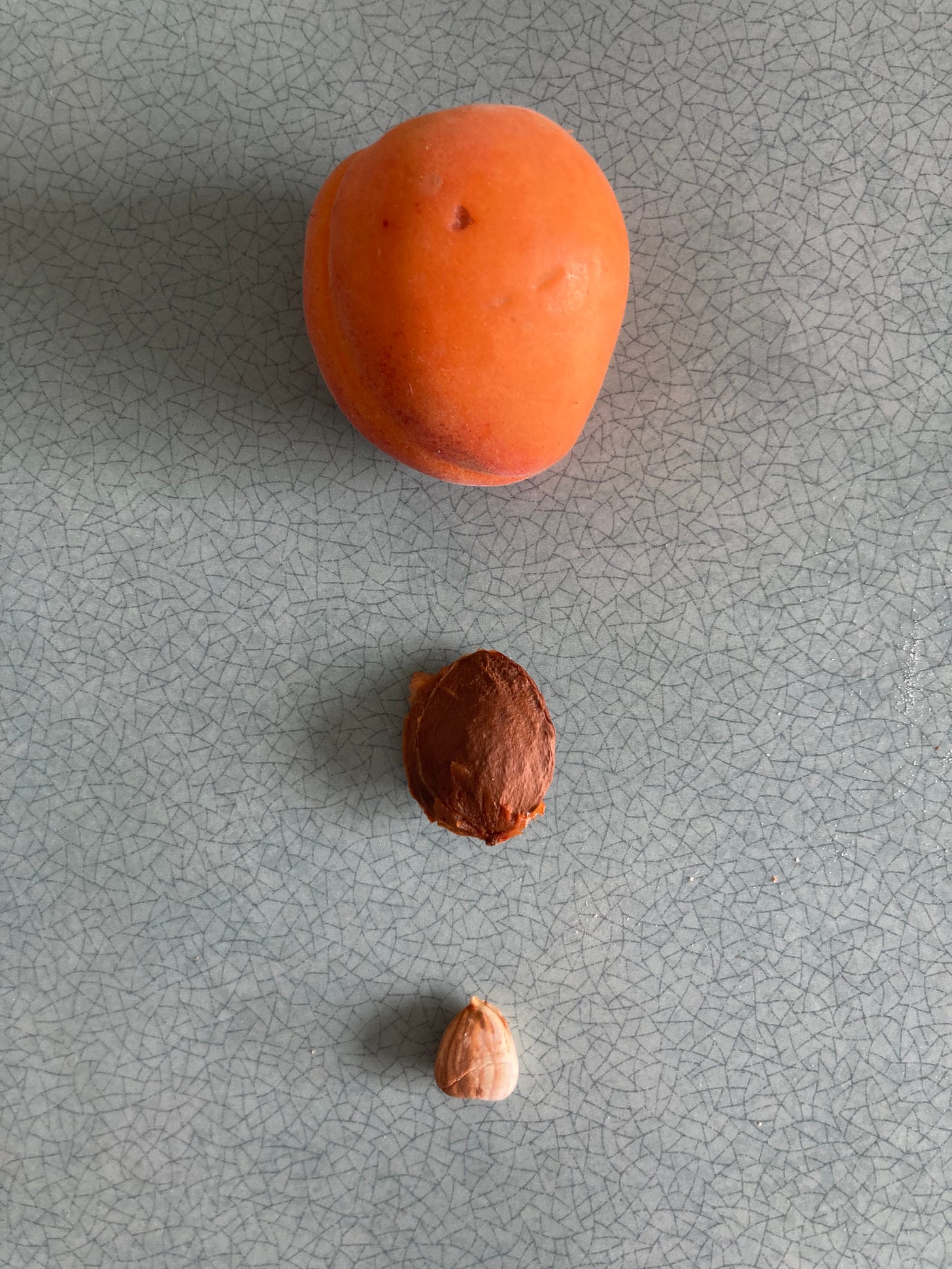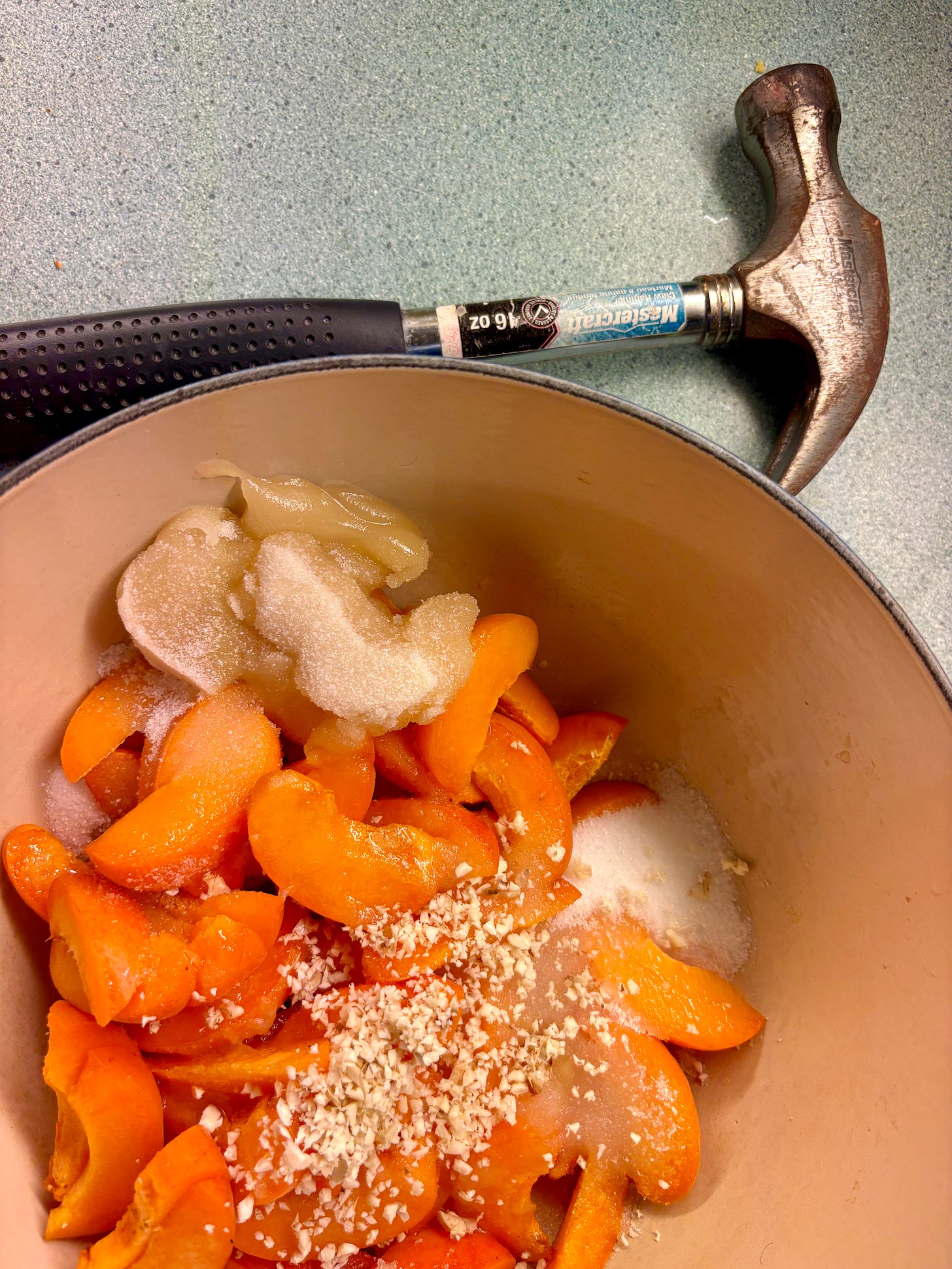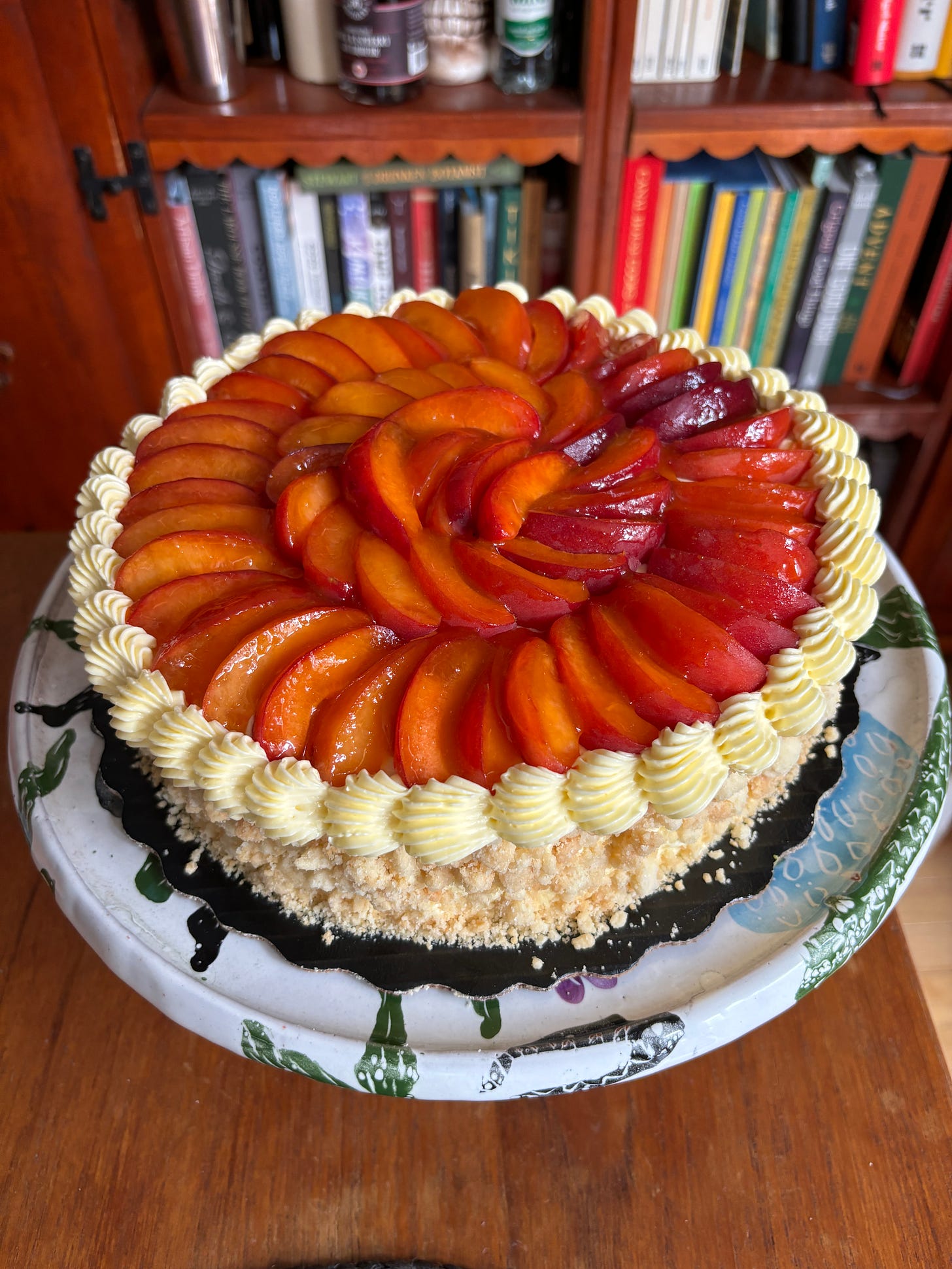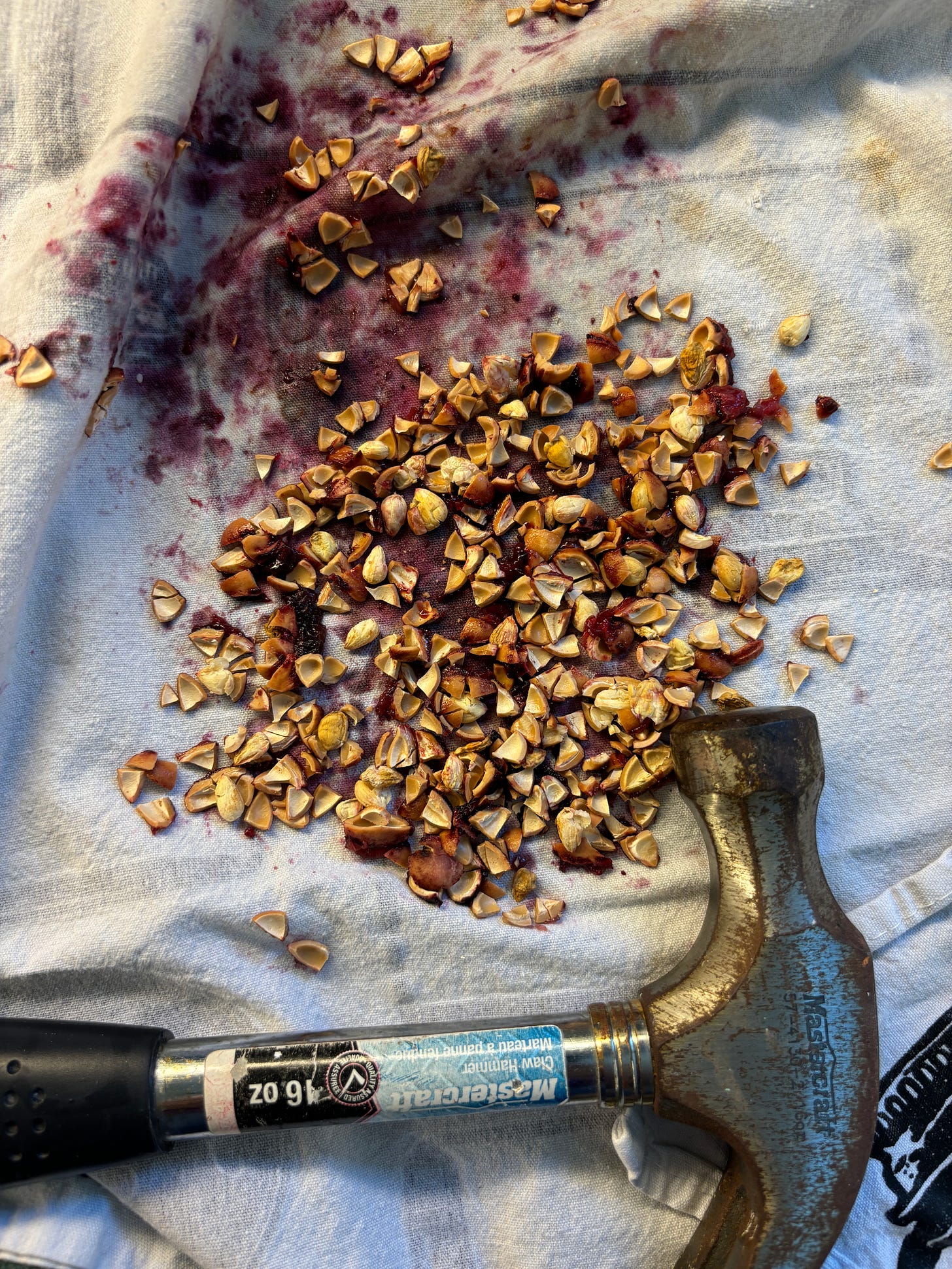Kitchen Project #144: All About Noyaux (aka Fruit Pits)
Dangerous Goods by Camilla Wynne returns
Hello,
Welcome to today’s edition of Kitchen Projects. Thank you so much for being here.
Today the brilliant Camilla Wynne is back with another installment of DANGEROUS GOODS (read the first instalment here), where she investigates ingredients with a dark side. In this newsletter, Camilla tackles NOYAUX, the poisonous but very delicious pits at the heart of stone fruit and the flavour you know and love in almond extract. Along with a history (and guide to AVOID being poisoned!), Camilla shares how to make your own extract along with a gorgeous apricot noyaux jam.
Over on KP+, she’s turning that jam into an Apricot Noyaux Cake of dreams (jam inside, genius, perfect for people that want layer cakes without the faff) with streusel and juicy apricot topping. Click here to make it!
What's KP+? Well, it's the level-up version of this newsletter. By joining KP+, you will support the writing and research that goes into the newsletter (including the commissioning - and fair payment - of all the writers), join a growing community, access extra content (inc., the entire archive with 300+ recipes) and more. Subscribing is easy and only costs £6 per month or just £50 per year (equivalent to £4.10 per month). Why not give it a go? Come and join the gang!
Love,
Nicola
DANGEROUS GOODS #2: NOYAUX
by Camilla Wynne / @Camillawynne
I think it was first in the Chez Panisse Fruits cookbook that I read about adding apricot kernels to apricot jam to impart a pleasant almond flavour. I tried it and was pleased and thought no more of it, until someone frenzied on the Internet told me that if I consumed it, I’d be on the brink of death!
This obviously confused me—why had Alice Water published such a dangerous recipe? Why weren’t Chez Panisse’s customers dropping like flies? Come to think of it, what about the beloved cookie, amaretti di Saronno, which I’d been told were made with apricot kernels rather than almonds? I’d eaten plenty of those. Around the world people consume cyanide-harbouring apricot kernels and their ilk—cherry pits, peach kernels and bitter almonds (which are a variety of almond, the OG source of almond extract!) . The latter are what makes pure almond extract, while cherry kernels are ground up to make mahleb, a spice popular in many cuisines but the Middle East in particular. German persipan is a marzipan made of peach and apricot kernels, and in China and Japan apricot kernels are used to make sweet almond “tofu.” I even remember eating an apple core once as a schoolyard dare—yet here I am, writing to you.
The mystery of fruit pits as an ingredient, both delicious and potentially poisonous, can be a bit difficult to unravel, which in some cases leads people to just wholesale disavow them and panic when others dabble. As we know from our examination of liquorice, it is of course the dose that makes the poison. Many of the foods we consume regularly can make us sick if treated improperly or consumed in too great a quantity.
The seeds of stone fruits, citrus and pome fruits, as well as bamboo shoots, cassava and some varieties of lima bean all contain cyanogens, whose bitter flavor and poisonous nature serve as warning to animals wishing to eat them. When chewed, the cyanogens in these foods mix with a plant enzyme that produces hydrogen cyanide. All of these are foods that people enjoy or rely on for nourishment, so we have somehow invented ways to make them safe for human consumption. In the case of stone fruit kernels, we love them and want to eat them because they contain benzaldehyde, which for the layman is basically the delicious flavor of almond extract. But cyanide poisoning can cause nausea, headaches, fever, insomnia, lethargy, aches and pains and, eventually, death, so it’s obviously best avoided. Apricot kernels contain anywhere from 0.05 to 5 milligrams per gram, while peaches clock in a little lower at 0.4 to 2.6 milligrams per gram. Studies have shown that up to 5 mg of cyanide a day can be effectively detoxified by our liver, but even just double that can result in cyanide poisoning in either the short or long term.
So the safe dose might just be one apricot kernel per day. But keep in mind that’s when we’re talking about daily consumption as well. Eating 3 in a day very occasionally would no doubt be fine—or at least it’s something I’d personally be comfortable with. The lethal dose of cyanide is .5 to 3.5 mg per kg body weight, so I’d have to eat considerably more than 3 to kick the bucket. In the US there have been reports of non-fatal poisoning after people consumed between 20 and 40 kernels at a time.
A poisonous superfood?
It's worth mentioning that on the other end of the spectrum, there’s a debunked belief that eating apricot kernels, along with other foods containing amygdalin like bitter almonds, can cure cancer. Still regarded by some as a superfood, you can buy bags of apricot kernels at health food stores for snacking—though with a fine print warning that one must not consume more than 2 to 3 per day that seems to me like a very paltry snack indeed.
In fact, in 2017 a Canadian man unwittingly bought a bag at a health food store (one that I used to sometimes frequent myself) in Montreal and ate nearly half the bag before his friend told him they were poisonous in large doses, and he hightailed it straight to the hospital. One hates to think what would’ve happened were it not for that friend. In 1993, the New York State Department of Agriculture tested the cyanide content of two 220 gram packages of bitter apricot kernels being sold in health-food stores as a snack. It turned out that each package, if consumed in its entirety, contained at least double the minimum lethal dosage of cyanide for an adult. Needless to say, the product was removed from stores.
How to ‘treat’ noyaux
It’s surprisingly difficult to find a straight answer about how to detoxify fruit pits. Methods have been developed and patents filed for treating them commercially, but it’s murky waters for home cooks. I’ve generally heard people say you need to roast them at 300°F or 350°F for 10 minutes to render them safe for consumption, but I can’t find much in the way of anything official to support that. The Singapore Health Agency says roasting is ineffective but boiling for 30 minutes will do the trick. In this study of bitter almonds, roasting was found to be the least effective method for removing cyanide, but I don’t think we’re about to all go out and get a set up to treat apricot kernels ultrasonically. This person reckons roasting works, but you’d have to grind them and get them wet first—and that it would negatively impact the flavor, since the boiling point of benzaldehyde is 178°C. The truth is, I usually don’t treat them at all before using them.
At the end of the day, I wouldn’t snack on untreated apricot kernels or drink a cherry liqueur made with a 2:1 ratio of alcohol to pits (estimated to contain 25.5 mg cyanide per 1 oz shot), but I’m happy to partake occasionally of small amounts of foods flavored with stone fruit kernels. In his excellent book Saving the Season, author Kevin West actually sends his homemade apricot jam, containing 9 whole apricot kernels in a 200 g jar, to a lab for testing. It contained the lab’s lowest detectable limit of cyanide, less than 1 mg per kilogram, so less than 0.2 mg in the entire jar. Those results are excellent news to me and my proclivity for adding those delicious little kernels to my jam.
If you too are undeterred, depending on how many kernels or pits you’re planning to use, and how much fruit you’re using simultaneously, you may or may not have an easy time getting the desired amount all at once. If you need a large quantity but don’t need the fruit, there’s no need to eat a whole pound of apricots and make yourself ill. Just save the pit every time someone in your household enjoys some stone fruit, then pop it in the freezer in an airtight container or freezer bag, and soon enough you’ll have collected a good amount. Don’t keep them in the refrigerator, as they are as prone to mold as any fruit and won’t last much longer than a week or so.
Are all stone fruits created equal?
In terms of bang for buck, I feel like apricot kernels are a classic for a reason. The kernels are larger than plum or cherry kernels and their almond notes stronger than that of peach. They create a satisfyingly milky noyaux. That said, if you have a ton of the other fruit around, there's no reason not to use it--and no particular reason not to mix and match!
Just before using, extract the kernel from the pit. People have all sorts of ways of accomplishing this task, whether putting a nutcracker, pliers or mallet to use. Personally speaking, I like the good old fashioned, slightly violent method of spreading my pits out on half of a clean tea towel, folding it over to contain any flying bits of debris, then smacking them all resolutely with a hammer.
For apricots, peaches or large plums, I like to discard the hard pieces of pit and save just the kernel. They sometimes get a little smashed, but that’s all the better for releasing the cyanogens! Cherries would be too small and fiddly to do this with, so they’re best just infused wholesale, pit and all, into cream, liquor or what have you before straining. Actually the best use of damson pits I’ve found is Anna Higham’s recipe for damson stone vinegar in her excellent book, The Last Bite. She uses the deliciously almond-scented fruit vinegar to flavor a fudge. It must simply be used sparingly.
How to make Almond Extract
To make an extract, you can choose whether to first roast the kernels in the oven in an attempt to drive off some cyanide. I didn’t do so myself as I don’t plan on chugging it. As a base, I use 15 g (1 Tbsp/0.5 oz) of vodka per apricot kernel (or 2 plum kernels or 3 cherry pits), though you could also use brandy or even a golden rum. To be honest, when I refill my homemade vanilla extract bottle I use whatever I have on hand, including bourbon. But I do think vodka is ideal to let the flavor shine. Usually instructions say to steep for 3 months before using, but I have to say mine was pretty flavorful after just two weeks. I used a little, and I’ll keep popping kernels in when I think of it, and I’m sure in a few months from now it’ll be really punchy. It’s an infinite batch of noyau!
That said, if you prefer to live your life as safely as possible, please know you can substitute pure almond extract (or even amaretto) in any of the following recipes and still enjoy their immense deliciousness.
Recipe: Small Batch Apricot Jam with Noyaux
Makes 550 g
If you’re intimidated by making jam, a small batch is where to start. It’s infinitely easier and makes just enough that there’s no need to jar it. If you make it for the cake recipe that follows, you’ll still have 220 g left to eat slathered on scones or buttered sourdough. And If I’ve scared you, feel free to roast the apricot kernels for 10 minutes at 300°F to neutralize the poison—but I never have!
Ingredients
520 g Apricots
150 g White sugar
100 g Honey
25 g Lemon juice
Method
Halve the apricots, reserving the pits. Slice them and combine in a medium bowl with the sugar, honey and lemon juice. Crack the pits and remove the kernels; chop finely and add to apricot mixture. Cover and let sit at cool room temperature overnight, or in the refrigerator for up to 1 week.
Transfer the mixture to a wide, heavy-bottomed pot. Bring to a boil over medium-high and cook, stirring occasionally at first and more frequently as it thickens, until the setting point is reached. The jam should fall in clumps from the spatula when held aloft, and with this small a quantity you should also be able to drag the spatula through and see the bottom of the pot for a second. If unsure, remove pot from heat and place a tsp of jam on a plate in the freezer for two minutes. Once chilled, push it gently with your finger. If it wrinkles, it’s ready. Transfer to clean containers (I like glass jars) and refrigerate. It should last at least 3 months, if not far longer.
Take this jam to the next level by using it in the Apricot Noyaux Cake, with jam inside, a noyaux scented buttercream, streusel on the outside and beautiful fruit on top. - click here for the recipe
Camilla Wynne is a a recipe developer & cookbook author based in Toronto, Canada, specializing in preserving & pastry. Her books ‘Preservation Society Home Preserves’ and ‘Jam Bake’ are available now. Her latest, Nature's Candy , is out October 22nd and available to pre-order now!












My wife is from Armenia - the home of the world's best apricots(that is why the latin name for Apricot is "Prunus armeniacum", or Armenian plum). She tells me that during apricot season everyone, and this very much includes children, eat handfuls of the kernels as if candy. So far no related fatalities :-)
Now I must know the cherry pit story!